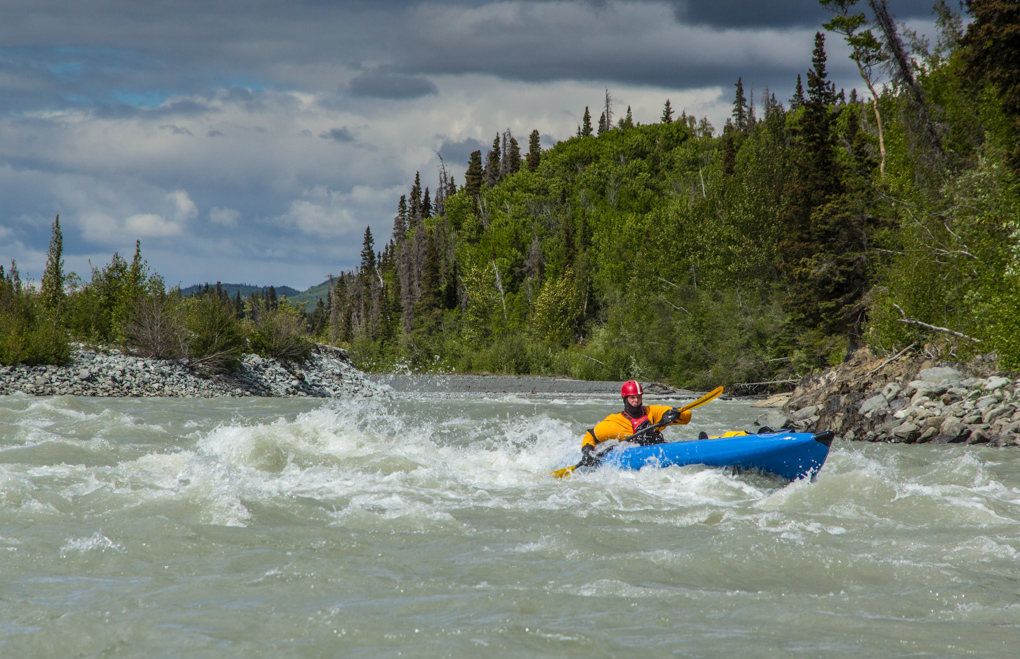Safety and Durability
The Leafield C7 valves on the Outlaw II functioned well, and we hardly lost air while on the river for almost two weeks. The tube construction was top notch, and in terms of abrasion resistance, the valves are very durable.
At one point we had to portage our gear to reach camp, and instead of unloading all the gear, we simply picked up the fully loaded boat from both ends and walked to camp. The tubes certainly sagged in the middle under the 100 lb. load, but they still handled it quite well.
I took the Outlaw II down a run of the Rio Chama in New Mexico at a mere 100 cfs and was concerned that a tube would pop from sliding over so many rocks. While the protective floor liner on the underside of the boat was certainly scraped up, I haven’t had a leak yet in over 30 days of abusive boating in Colorado and Alaska. Additionally, hard-rubber nose caps protect the bow and stern portions of tubing, which come in handy when you botch a line and t-bone a nearby rock.

I haven’t had the opportunity to test the strength of the bow and stern handles or the stainless steel D-rings in a pin or wrap situation yet. The D-rings are glued on, and likely are not all that strong. The bow and stern handles were also fine under 75 lbs of pressure while carrying the loaded IK. This could be an issue if you pin a boat, but you can always deflate the tubes to attempt to facilitate extraction.
The Outlaw II was very easy to right in the event of a flip, which is crucial for those just beginning to navigate whitewater. The numerous drain holes are easily accessible on the underside of the IK, and reaching across to the holes on the opposite side gives enough leverage to right the boat even when fully loaded. We appreciated this feature while getting a feel for the Outlaw II in the Class III canyon at the start of the Tatshenshini.
The dark orange color was also excellent for visibility while on the river.
Comfort
The Outlaw II has two inflatable thwarts that can be used as backrests or seats. The thwarts are secured to the IK through buckles that thread through the drain holes, which allows for fore-aft adjustment. That being said, adjustment isn’t easy when the floor insert is inflated, making it difficult to run a buckle between the edge of the floor and the tube. Your best bet is to adjust the thwart position prior to inflating the floor. I found that it’s better to have a little more weight distributed toward the back of the boat, which lifts the bow, effectively providing more bow rocker for easy riding up and over waves.
The thwarts themselves are comfortable for a quick day run on whitewater, but provide minimal back support. Additionally, if your total load is over 350 lbs, you’ll likely be sitting in a bit of water. For multi-days where comfort is the highest priority, I recommend bringing a Crazy-Creek style chair for additional back support. I also ended up sitting on my gear duffel quite often to stay out of the water and in a more relaxed sitting position.
Value
The NRS Outlaw II is a bargain compared to more high performance IKs. AIRE’s Tributary Series Tomcat Tandem is just a tad cheaper at $749, but most other tandem IKs start around $1,500. It seems that NRS was able to drop the price on the Outlaw by using the PVC coated polyester, but I haven’t seen any significant disadvantages to this material regarding abrasion resistance. My Outlaw II has been bombproof so far, although the lifespan of PVC coated materials is typically about half that of urethane coated materials.
You don’t get fancy or easily adjustable seats with the Outlaw II, but a little customization will go a long way for those multi-day trips.
The Outlaw II could be improved in a couple of ways, specifically regarding drainage and larger tubes. If there were larger tubes on the IK, it would take more water to fill the interior. As it stands now, a couple inches of water will make the IK feel swamped, and a single wave can easily dump that much water into the boat. My experience with higher-end IKs is limited, although it shouldn’t be that expensive to have a good self-bailing system on a boat.
Bottom Line
We used the budget-minded entry level NRS Outlaw II for a 12-day trip down a remote river in Alaska and it held up great. Uses for an IK don’t get much more rugged than what I’ve put it through, so I am dubious that shelling out double the price for a higher-end IK is truly worth it. In the long run it may be worthwhile if the urethane fabrics outlive the PVC fabric, but in the short term the PVC worked beautifully.
Those looking for an IK to use on day-trips will find the Outlaw II to be much more sporty than those looking for an expedition boat. Beyond that, the Outlaw II has a simple and reliable design that has worked very well for my IK endeavors. If you’re looking for a finely tuned performance machine it may be worth looking into pricier IK options.

Going to get. Looks fantastic :D
I am using AIRE Super Lynx Kayak. It’s very nice and feeling comfortable. According to your Description “NRS Outlaw II Inflatable Kayak” will also better and Low prices.
Thanks for the in-depth review!
The newer models have solved the problem with self bailing drain holes. Their is now some space between the floor and side tubes to make for easier drainage.
Eh, I got what I think is a newer model, and I still sit in water. Beautiful boat, love it, but your fanny does get wet.:)